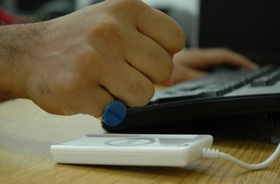Barrier-free technology coming of age in UW Trace Center project
Despite the rapid increase in access to and use of the Internet, barriers still exist for a wide variety of users: people with disabilities, people who are aging, and people who have literacy challenges.
Researchers at the University of Wisconsin–Madison’s Trace Research & Development Center are working in conjunction with an international consortium to remove these barriers with a concept which is set to revolutionize the way millions of people get on the information superhighway.

A ring like this, which contains an electronic chip, could help people with disabilities or the elderly access Web-based services through a simple interface.
Known as the Global Public Inclusive Infrastructure (GPII), the concept proposes instant and automatic personalized access to any computer, phone, or other device.
GPII will help empower Internet users with disabilities to increasingly harness the power of cloud-based computing, enabling kiosks to speak, font sizes and screen resolution to adjust with instant ease, and thermostats and other devices we use daily to adjust from complex to simple interfaces instantly depending on the user.
The GPII concept is being demonstrated today (June 5, 2012) at the 5th Cloud Computer Forum and Workshop, sponsored by the U.S. Department of Commerce’s National Institute of Standards and Technology (NIST) in Washington, D.C. One of the demonstrations will show how elderly people can use mainstream Web-based services like Google’s Gmail, Picasa, and Talk through a simplified interface.
Each type of interface will automatically adjust to a more understandable form when activated by a ring or card containing a small electronic chip by the user. The interface shows pictures of a mailbox, a photo album, and an address book, enabling the user to avoid an overly complex set of menus and other options.
“The goal is to enable all to access and use the Internet and all its information, communities, and services for education, employment, daily living, civic participation, health and safety,” says Gregg Vanderheiden, director of the Trace Center and professor of industrial and systems engineering. “The GPII concept is a paradigm shift.”
Enjoy this story?
Read more news from the College of EngineeringSubscribe to Wisconsin Ideas
Want more stories of the Wisconsin Idea in action? Sign-up for our monthly e-newsletter highlighting how Badgers are taking their education and research beyond the boundaries of the classroom to improve lives.
